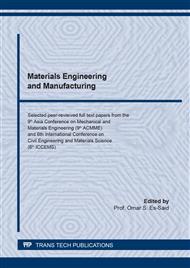[1]
Jiang M F, Cui Y Y, Wang D Y, et al. Effect of Modification Treatment for Reduction of Dephosphorization Slag in Hot Metal Bath[J]. Journal of Iron and Steel Research International, 2013, 20(1):1, 20-6, 20.
DOI: 10.1016/s1006-706x(13)60036-9
Google Scholar
[2]
Wang Y M, Tao L, Guo H Y, et al. Dephosphorization influence factors in converter hot metal pretreatment[J]. Iron and Steel, 2020, 55(9):29.
Google Scholar
[3]
Yang X, Matsuura H, Tsukihashi F.Reaction behavior of P2O5 at the interface between solid 2CaO-SiO2 and liquid CaO-SiO2-FeOx-P2O5 slags saturated with solid 5CaO·SiO2·P2O5 at 1573 K[J]. ISIJ International, 2010, 50(5):702.
DOI: 10.2355/isijinternational.50.702
Google Scholar
[4]
Zhao X, Song Q, Wang T Y. Enlightenment of the reorganization and collaboration of Nippon Steel Corporation and Sumitomo Metal Industries, Ltd. for Chinese steel industry[J]. China Metallurgy, 2015, 25(12):1.
Google Scholar
[5]
Yoshida K, Yamazaki I, Tozaki Y, et al. Development of effective refining process consisting of both hot metal pretreatment and decarburization in two top and bottom blown converter[J]. Tetsurto-Hagane, 1990, 76(11):1817.
DOI: 10.2355/tetsutohagane1955.76.11_1817
Google Scholar
[6]
Huang Xihu. Principles of iron and steel metallurgy [M]. Metallurgical Industry Press, (2013).
Google Scholar
[7]
KI Shimauchi, SY Kitamura, H Shibata. Distribution of P2O5 between Solid Dicalcium Silicate and Liquid Phases in CaO–SiO2–Fe2O3 System[J]. ISIJ International, 2009, 49(4):505-511.
DOI: 10.2355/isijinternational.49.505
Google Scholar
[8]
Suito H, Inoue R . Behavior of Phosphorous Transfer from CaO-FetO-P2O5(-SiO2) Slag to CaO Particles[J]. Transactions of the Iron & Steel Institute of Japan, 2006, 46(2):180-187.
DOI: 10.2355/isijinternational.46.180
Google Scholar
[9]
Inoue R, Suito H. Phosphorous partition between 2CaO·SiO2 particles and CaO-SiO2-FetO slags[J]. ISIJ International, 2006, 46(2):174-179.
DOI: 10.2355/isijinternational.46.174
Google Scholar
[10]
Inoue R, Suito H. Mechanism of Dephosphorization with CaO-SiO2-FetO Slags Containing Mesoscopic Scale 2CaO×SiO2 Particles[J]. ISIJ International, 2006, 46(2):188-194.
DOI: 10.2355/isijinternational.46.188
Google Scholar
[11]
Xie S, Wang W , Liu Y , et al. Effect of Na2O and B2O3 on the Distribution of P2O5 between Solid Solution and Liquid Phases Slag[J]. ISIJ International, 2014, 54(4):766-773.
DOI: 10.2355/isijinternational.54.766
Google Scholar
[12]
Lv Y C, Wang X H, Qin D P, et al. Enrichment and influencing factors of phosphorus in slag of converter steelmaking[J]. Iron and Steel, 2017, 52(10):29.
Google Scholar
[13]
Manning C P, Fruehan R J. The rate of the phosphorous reaction between liquid iron and slag[J]. Metallurgical and materials transactions B, 2013, 44(1): 37-44.
DOI: 10.1007/s11663-012-9757-9
Google Scholar
[14]
B. bet KB. The effect of temperature on the phosphorus reaction in the basic steeling process[J]. Journal of The Iron and Steel Institute, 1946.1:115.
Google Scholar
[15]
Qu Ying. Principles of steelmaking [M]. Metallurgical Industry Press, (1994).
Google Scholar
[16]
Yang W, Yang S, Li J, et al. Dephosphorization by Double-Slag Process in Converter Steelmaking[J]. High Temperature Materials and Processes, 2017, 37(7):625-633.
DOI: 10.1515/htmp-2016-0250
Google Scholar
[17]
Su C, Yu J, Wang H. Formation mechanism of 2CaO·SiO2-3CaO·P2O5 solid solution [J]. Journal of Northeast University (NATURAL SCIENCE EDITION), 2013, 34 (10): 1434-1437.
Google Scholar
[18]
Huang X H. Principle of Iron and Steel Metallurgy [M]. Beijing : Metallurgical Industry Press, (2013).
Google Scholar
[19]
Tian Z H, AI L Q, Cai K K, et al. Deep dephosphorization of molten steel with CaO-CaF2-FeO slag [J]. Journal of iron and steel research, 2004 (05): 23-27.
Google Scholar


